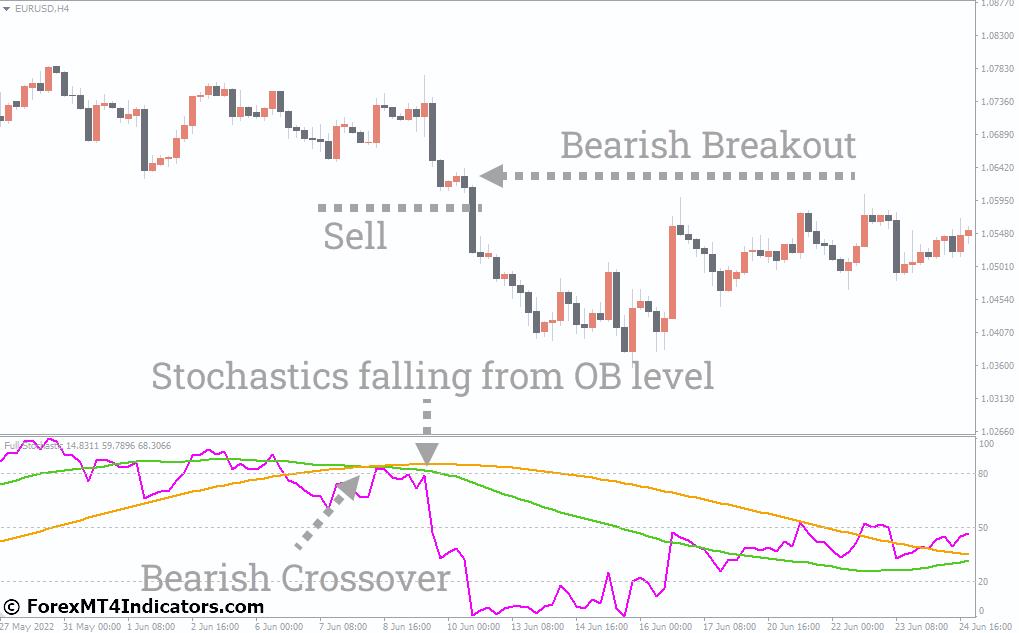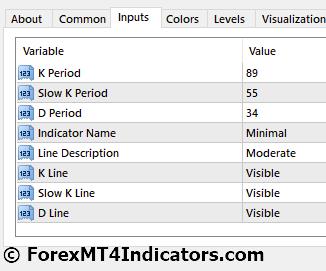The magic behind the Full Stochastic lies in its calculations. It primarily focuses on the relationship between the current closing price and the price range over a specific period. Here’s a breakdown of the key elements:
Crafting Your Trading Arsenal: Strategies with the Full Stochastic
Now that you’re equipped with the knowledge to interpret the Full Stochastic’s signals, let’s explore how to incorporate it into your trading strategies:
-
Crossovers: As mentioned earlier, a crossover above the %D line can be a bullish signal. You could consider entering a long position (buying) when this occurs, especially if accompanied by other confirming factors like a bullish price pattern or increasing volume. Conversely, a crossover below the %D line suggests a bearish signal, potentially indicating an entry point for short positions (selling) if supported by other technical indicators.
-
Divergence Trading: Divergence between the price and the Full Stochastic can be a powerful tool. If the price keeps rising while the Full Stochastic heads downwards, it suggests a possible trend reversal. This could be a selling opportunity, especially if the indicator is nearing the overbought zone. Conversely, if the price is dropping, but the Full Stochastic is rising, it might indicate a potential buying opportunity as the market could be oversold.
-
Combining the Full Stochastic with Other Indicators: Remember, the Full Stochastic is just one piece of the puzzle. For a more comprehensive analysis, consider combining it with other technical indicators like:
- Moving Average Convergence Divergence (MACD): This indicator gauges momentum and potential trend reversals.
- Relative Strength Index (RSI): Similar to the Full Stochastic, the RSI measures market momentum and identifies overbought and oversold zones.
- Support and Resistance Levels: These price points often act as boundaries, and the Full Stochastic’s signals near these levels can hold more weight.
Developing a Personalized Trading System
By experimenting with different strategies and backtesting their effectiveness on historical data, you can craft a trading system that aligns with your risk tolerance and trading goals.
Expert Tip: Don’t jump straight into live trading with a new strategy. Paper trading allows you to test your approach in a simulated environment without risking real capital. This helps you refine your strategy and gain confidence before deploying it in the live market.
Unveiling the Strengths and Weaknesses
Strengths of the Full Stochastic
- Responsiveness: The indicator reacts swiftly to price changes, making it suitable for identifying short-term trading opportunities.
- User-friendliness: The concept behind the Full Stochastic is relatively straightforward, making it accessible to traders of various experience levels.
- Customization: As discussed earlier, the ability to adjust the indicator’s parameters allows for personalization based on individual trading styles.
Weaknesses of the Full Stochastic
- False Signals: The indicator can generate false signals, especially during periods of high market volatility.
- Lag: Due to its inherent smoothing mechanisms, the Full Stochastic might lag behind price movements, potentially causing delays in signal generation.
- Over-reliance: Solely depending on the Full Stochastic for trading decisions can be risky. It’s crucial to combine it with other forms of analysis for a well-rounded approach.
Addressing Limitations
The key to mitigating the weaknesses of the Full Stochastic lies in strategic implementation:
- Confirmation Techniques: Always combine the Full Stochastic’s signals with other indicators like support and resistance levels or volume analysis for confirmation before entering a trade.
- Proper Risk Management: Always adhere to sound risk management practices, such as using stop-loss orders to limit potential losses.
- Backtesting and Refinement: Continuously backtest your strategies using historical data and refine your approach based on the results.
Remember, successful trading requires a blend of technical knowledge, experience, and a healthy dose of discipline.
Advanced Applications of the Full Stochastic
While the core concepts have been established, the Full Stochastic’s versatility extends beyond basic applications:
- Multiple Timeframe Analysis: Analyzing the indicator on different timeframes (e.g., daily, hourly) can provide a broader perspective on market trends and potential entry/exit points.
- Combining with Volume Analysis: When the Full Stochastic generates a signal, assessing the accompanying volume levels can add confirmation strength. High volume alongside a signal can indicate a stronger market move.
Exploring Algorithmic Trading
For traders seeking automation, the Full Stochastic formula can be integrated into algorithmic trading strategies. However, this approach requires advanced programming knowledge and a thorough understanding of the risks involved.
Ethical Considerations
Algorithmic trading should always be conducted ethically and responsibly. Backtesting and proper risk management are essential to avoid market manipulation and ensure fair trading
The Full Stochastic as a Trusted Tool
The Full Stochastic indicator serves as a valuable companion for MT4 traders, offering valuable insights into market momentum and potential trading opportunities.
Recap of Key Features and Benefits
- Gauges market momentum: By analyzing the relationship between the current price and the recent price range, the Full Stochastic helps identify potential turning points in the market.
- Identifies overbought/oversold zones: The indicator’s readings within specific ranges can suggest areas where the market might be due for a correction or a potential rebound.
- Provides confirmation signals: Crossovers between the %K and %D lines and divergence between price and the indicator can offer additional confirmation for trade decisions.
- Customizable: The ability to adjust the indicator’s parameters allows traders to tailor it to their trading styles and risk tolerance.
How to Trade with Full Stochastic Indicator

Buy Entry
Crossover above the %D line: This can signal a potential upswing. Consider buying only if accompanied by:
-
-
- Price moving above a support level.
- Increasing volume.
Oversold zone (below 20): If the price starts rising while still in the oversold zone, it might indicate buying interest. Proceed with caution as false signals are possible.
Sell Entry
Crossover below the %D line: This can signal a potential downswing. Consider selling only if accompanied by:
-
-
-
- Price moving below a resistance level.
- Decreasing volume.
Overbought zone (above 80): If the price starts dropping while still in the overbought zone, it might indicate selling pressure. Exercise caution due to potential false signals.
Full Stochastic Indicator Settings

Conclusion
The Full Stochastic empowers MT4 traders with a valuable tool to navigate the ever-changing market dynamics. By understanding its functionalities, and limitations, and implementing it within a comprehensive trading strategy, you can increase your chances of success in the ever-evolving world of finance. Remember, discipline, a commitment to learning, and a combination of various analytical tools are the cornerstones of effective trading.
Recommended MT4 Broker
- Free $50 To Start Trading Instantly! (Withdrawable Profit)
- Deposit Bonus up to $5,000
- Unlimited Loyalty Program
- Award Winning Forex Broker
- Additional Exclusive Bonuses Throughout The Year

>> Claim Your $50 Bonus Here <<

(Free MT4 Indicators Download)
Click here below to download:
Full Stochastic MT4 Indicator
.png) InvestingStocksToolsClubsVideosPrivacy PolicyTerms And Conditions
InvestingStocksToolsClubsVideosPrivacy PolicyTerms And Conditions
